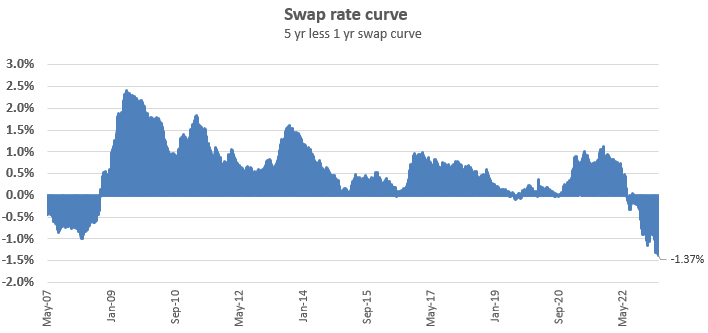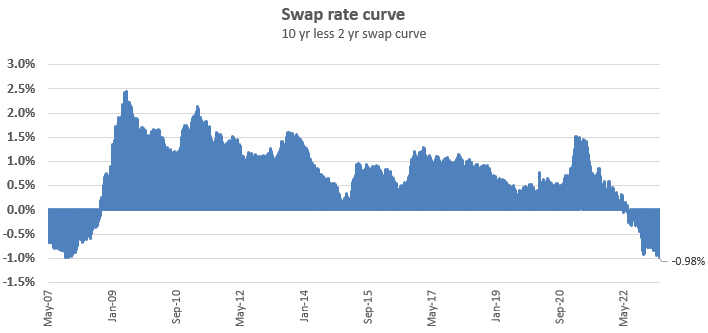
Wholesale interest rates have set some new benchmarks following Wednesday's better-than-expected labour market reports.
The employed workforce is growing faster than expected, immigration is ramping up, and labour costs are still rising fast. The benchmark for labour cost rises are what will constrain inflation, and at current rates of increase these labour costs are still about double what will be required to get back to the RBNZ's inflation target.
As a consequence, financial markets are bidding up wholesale interest rates at the 'short end'.
And that is because they can't see the RBNZ stopping its rate hiking track if inflation is going to stay elevated.
Meanwhile, the international background is that rate hikes may be coming to an end. The May US Fed position removed its reference to future rises being necessary
So we are left with the RBNZ-influenced short end rates rising, and the internationally-influenced long end stable or now possibly falling.
At the end of trading on Wednesday, May 3, 2023, the one year swap rate rose +5 bps to 5.70% and the two year swap rate rose +5 bps to 5.16%. From the end of March, these are up +36 bps and +14 bps respectively.
Meanwhile the five year swap rate was unchanged at 4.33% yesterday and the 10 year fell -3 bps to 4.18%. From the end of March, these are down -9 bps and -11 bps respectively.
The result is that we now have some significant rate inversions, as large or larger than what we had during the GFC.


The GFC was followed by many years of sub-par economic performance, even though positive rate curves returned for much of that period. (Just saying.)
But positive yield curves do have an upside. It will be the short end that adjusts, and absent other changes, that might make home loan rates for one and two year terms more like what we now have for longer terms (sub 6%) and possibly even lower.
Daily swap rates
Select chart tabs
13 Comments
Does the RBA (or FED) have more control over rates than the RBNZ or was their enough inflationary stats released this week to otherwise justify this? What do people think?
With long term rates still going up, I don't think we have reached the bottom of this credit squeeze yet. It can't be good for recovery if we have the most mortgaged distressed stuck on high rates if rates do go down.
"It will be the short end that adjusts"
Yes. But that can be on a relative basis to the rest of the curve. It may not mean that short-end rates fall.
Where would any of us borrow if we got a clue that the OCR was going to 15% because the CPI was going to spiral out of control? 1 year or 5?
The crucial thing is that you have the capacity to walk away from your current Lender - be able to meet whatever LVR,DTI ratios and age criterion that apply somewhere else.
Many people can't do that now, and that number will increase as each day passes. But if you can, that's your bargaining chip.
I'd echo what BW said.
Don't 'negotiate' with your existing lender until you've already done so with at least 3 other lenders. If the other lenders want to know why you're loking elsewhere then tell them their service is crap - get some stories ready about how crap. (Don't look at the carded rates as they're not the best rates available. And don't let them play games applying 'test rates'.) If your current lender will only match the best offer from the other three then go back to the best offer from the three and tell them your existing lender has matched their rate. You'll be amazed at the reaction (usually good). If your existing lender doesn't undercut your best offer by 0.25% they're treating you with contempt and you should leave. Be very careful of offer sweetners, like cashbacks, TV, etc. as they usually come with hooks. And don't go long. Short, when rates are high, long, when rates are low.
All banks are really working hard for new business at the moment. Make them work harder for you.
With the FED still raising rates, what you should be focused on is what they will be when the term ends and chances are the rates are going UP. I went 9 months on my current TD and didn't regret it because even the OCR went up the rates didn't for a couple of months. I have 6 months left and the 6 month is currently what I'm getting. The 12 month looks to be the highest at 5.70% but I think this will move to 6% by the end of the year.
#BankingCrisis Even the June '23 SOFR futures contract is right now being heavily bought after hours. This would mean a significant chance the situation escalates so much the Fed has to cut rates - at its next meeting in June. Tell us again about inflation risks. Link

We welcome your comments below. If you are not already registered, please register to comment.
Remember we welcome robust, respectful and insightful debate. We don't welcome abusive or defamatory comments and will de-register those repeatedly making such comments. Our current comment policy is here.